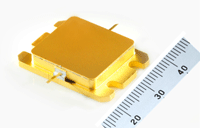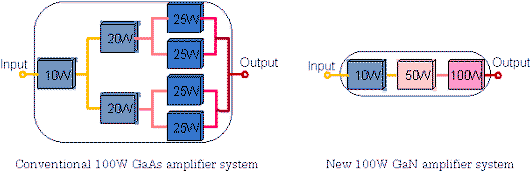- News
26 April 2012
Mitsubishi Electric boosts Ku-band satcom GaN PA output from 62W to record 100W
 Tokyo-based Mitsubishi Electric Corp has developed a prototype gallium nitride high-electron-mobility transistor (GaN HEMT) amplifier with record output power of 100W (50dBm) for Ku-band (14GHz) satellite communications. The amplifier is expected to contribute to smaller and lighter transmitters for terrestrial stations used in satellite communications.
Tokyo-based Mitsubishi Electric Corp has developed a prototype gallium nitride high-electron-mobility transistor (GaN HEMT) amplifier with record output power of 100W (50dBm) for Ku-band (14GHz) satellite communications. The amplifier is expected to contribute to smaller and lighter transmitters for terrestrial stations used in satellite communications.
Picture: Mitsubishi Electric’s new 100W Ku-band GaN amplifier.
Vital satellite communications require robust systems that must work under adverse conditions, such as during natural disasters, notes Mitsubishi Electric. High power output is required for radio transmission from terrestrial stations to satellites in geostationary orbit 36,000km above sea level. Also, terrestrial stations must be small enough to be transported by vehicles and installed.
Gallium arsenide (GaAs) amplifiers have commonly been used for satellite communication transmitters, but gallium nitride (GaN) amplifiers have become increasingly popular recently since GaN transistors can handle very high voltage.

Picture: Conventional 100W GaAs amplifier system versus 100W GaN amplifier system.
Mitsubishi Electric began to ship samples of C-band 100W GaN HEMT power amplifiers for satellite communications in 2011. The new Ku-band GaN HEMT amplifier (which has gain of 8dB) features a downsized configuration and a low-loss circuit. The 100W output power significantly increases that of the firm’s existing GaN HEMT amplifier (62W, 47.9dBm; 8dB gain) and quadruples that of its GaAs amplifier (25W, 44dBm; 5dB gain). The firm says that its new amplifier’s ability to perform the tasks of four conventional units represents can help to downsize transmitters to one sixth the size of a GaAs amplifier.
